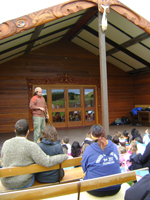"When we’re developing our curriculum do we really take into account the needs of the significant number of Māori children and their families in our school?”
This is the question the staff at North East Valley Normal School were pondering. Principal John McKenzie, talks about their curriculum development day that was held at their local marae.
We decided to hold our curriculum planning day at the Puketeraki Marae. In our school we recognise that everyone has a whole lot of different ideas and expertise, and we want to put these people in environments where something is going to happen. The environment of the marae was a catalyst for us to look at how to incorporate tikanga Māori into our curriculum. It was risky. We weren’t sure what was going to come out of it, but this seemed a common sense way forward. The marae had an effect on us as educators and as curriculum developers. It created quite a shift in our thinking.
The reason for holding our curriculum day at the marae was to ensure we were able to incorporate the important Māori world-view in our planning for the new curriculum. We had an interesting time. We were welcomed onto the Marae and given the history of the local area, but more importantly, we asked for some help in how we would plan units to incorporate things Māori.
Community voice
The New Zealand Curriculum encourages schools to seek out and listen to the values and expectations of the community when designing their local curriculum. North East Valley School worked with local iwi to find out the knowledge and values that are valued by mana whenua. Together they looked at ways to incorporate te reo Māori, te ao Māori, and Māori history into teaching and learning.
Diana Mules, facilitator for Te Reo Rakatahi I Otago (LEOTC programme), took us through some new ways of planning that encouraged us to consider:
- Whakapapa – creation stories, relationships
- Te wā (place and time)
- Te reo
- What knowledge, stories, waiata and proverbs, geology, geography, astronomy, and navigation could be added to planning?”
Diana explained that the LEOTC programme encourages schools to work in different ways, using the marae as a source of learning and knowledge. She encouraged teachers to see that the marae can be an enjoyable place to work. Her aim was to open the teachers’ eyes and hearts to allow things Māori to be a part of their teaching.
Treaty of Waitangi principle
North East Valley School is exploring how to reflect the Treaty of Waitangi principle in their local curriculum. By incorporating te reo Māori and tikanga in their teaching they are enabling Māori students to see themselves and their culture valued at school.
Diana adapted a template she discovered at an Indigenous Education Conference (WIPCE) in Australia, and is now working with a number of schools across Otago. The template considers the indigenous view in teaching. During the curriculum day, Diana worked with us to investigate how a Māori viewpoint can be shown through units of work such as floating and sinking. The importance of this investigation was to show the depth to adding Māori viewpoint.
Diana offered this advice to teachers:
“Learn more about the indigenous culture of Aotearoa so you are not afraid to weave it into the learning experiences for all children. Be especially aware of the history and aspirations of your local iwi and hapu. Don’t be afraid to ask them for help and trust that they do care about education. There is an opportunity – take it! Learn Te Reo and get involved in the Māori world. You can’t learn it from books. You need to experience things. This will open a whole new world to you and grow you as a teacher within the environment and people of Aotearoa.”
Our school will now take this powerful work started at the marae to reframe some of our thinking and to ensure a focus on what is relevant to children and families in the school who are Māori. Looking forward, we plan to incorporate marae trips into our three year planning cycle and ask our learning community, including early childhood centres, to join us.
The principles of the curriculum lead us to think more about diversity and the importance of the indigenous people of New Zealand. Our work at the marae will make it a real consideration.
You might like ...
Looking at the Treaty of Waitangi curriculum principle
Wharehoka Wano shares his ideas about the importance and meaning of the Treaty of Waitangi curriculum principle. Whare offers schools simple strategies to get started and describes what might be seen in classrooms where the Treaty of Waitangi principle is enacted.
Māori history
This site is designed to give you access to materials that will assist in the implementation of Te Takanga o te Wā, Guidelines for Teachers Years 1–8.
- Tags:
- community engagement
- primary
- treaty of Waitangi
Return to top

